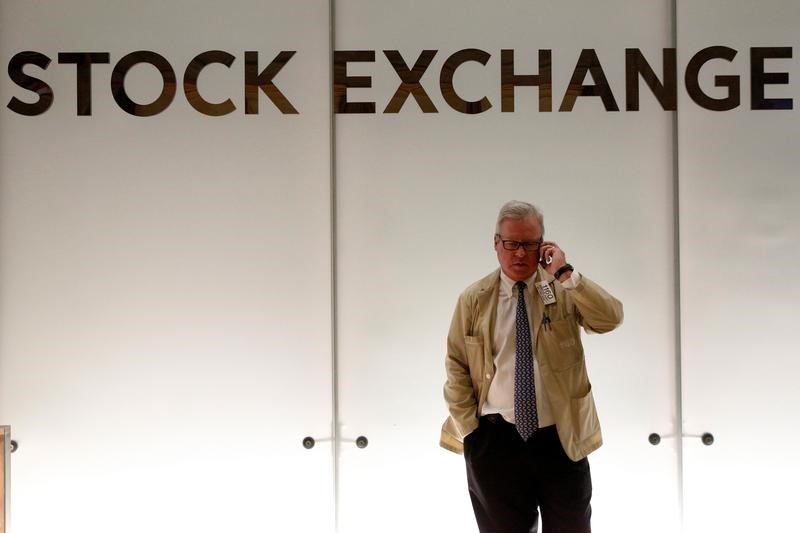By Ritvik Carvalho
LONDON (Reuters) - World stock markets suffered their worst tumble this week since February's violent shakeout with some $2.6 trillion of investor wealth lost, but there was no clear trigger apart from long-brewing worries on U.S. interest rates, trade wars, China and emerging markets.
Whatever the precise cause of this week's reversal, many investors are now wondering whether the confluence of all the negative factors means a prolonged correction of some sort is now inevitable.
For different segments of the market, that's already well underway. Down 25 percent from January's peaks, emerging market equity indices are already deep in a bear market. The MSCI World index (MIWO00000PUS) has broken below a key moving average for the first time since 2016.
(Graphic: MSCI World Index breaks below 200-DMA for first time since 2016 - https://reut.rs/2yIoplh)
So what sort of stress is being registered on investors' dashboard? Surprisingly perhaps, many 'early warning' signals from the financial system are still relatively calm.
Here are 11 charts capturing some of those measures of tensions in the banking system or investor risk aversion.
1) U.S. YIELD CURVE
(Graphic: Yield curves - https://reut.rs/2OpxBFS)
The gap between 10-year and 2-year U.S. Treasury yields is seen a bellwether of recession risk and turning economic cycles. A "flattening" curve is often considered a portent of slowing economic activity. An outright inversion where long-term interest rates fall below short-term rates has been a reliable red flag for recession in the past.
The U.S. curve has flattened significantly over the course of this year, but has actually steepened recently as yields on the U.S. 10-year Treasury bond hit 7-year highs.
While rising Treasury yields are cited as one cause of the equity shakeout as credit tightens and changes in the relative attractiveness of debt over equity, the steeper yield curve suggests the U.S. expansion at least has further to run than many had feared only a short time ago.
2) VIX
The benchmark measure of U.S. stock market volatility, sometimes referred to as Wall Street's "fear gauge". The index registered its second-biggest one-day rise this year as stocks sold off, but it remains well below levels seen in February.
Treasury bond volatility has also jumped to its highest since June, but remains far below February peaks. Currency market aggregate volatility gauges are firmer too but some distance from the early year highs.
(Graphic: VIX - https://reut.rs/2Om1JBF)
3) DOLLAR/YEN
The Japanese yen often appreciates in times of world market stress or risk aversion amid expectation of some repatriation of Japan's huge surplus savings from overseas markets. So far this year, the dollar has actually gained ground against the yen as the Fed tightened and Bank of Japan stood pat.
Even though the yen rallied during the latest selloff, it broke little new ground and merely returned to levels of a few weeks back against both the dollar and the euro.
(Graphic: Dollar/yen - https://reut.rs/2Opdd7x)
4) EURO ZONE SPREADS
The premium investors demand for holding Spanish or Italian sovereign bonds over benchmark German debt. Wider spreads indicate a greater degree of risk aversion with the euro zone and world markets.
The Italian-German spread has surged in recent months to its widest level since the 2011/2012 euro-zone debt crisis as investor took fright at the new Italian coalition government plans to boost its budget deficit. However, signs of contagion elsewhere in the euro zone, such as Spain, have been relatively limited.
(Graphic: Euro zone spreads - https://reut.rs/2yA4IvP)
5) FINANCIALS CDS
Worries over Italy as well as a currency crisis in Turkey have seen a noticeable tick-up in the prices of credit default swaps - or debt insurance - on European banks - the stocks of which have also been pressured due to their exposure to both countries' sovereign debt and domestic banking systems.
But these CDS levels remain well below the highs of early last year.
(Graphic: Financials CDS - https://reut.rs/2OlSguo)
6) GLOBAL HIGH YIELD BOND SPREADS
Merrill Lynch's global index of high-yield bonds, reflecting credit risk in the so-called "junk" market, a sector that will attract huge inflows of cash in good times but often one of the first sectors investors will flee from in bad. The real yield on the index has climbed steadily this year, hitting its highest since late 2016.
(Graphic: Global high yield bonds - https://reut.rs/2OlLKUt)
7) ITRAXX CROSSOVER
An index of sub-investment grade – or "junk" rated - European credit default swaps, effectively a measure of investors’ perception of credit risk and corporate borrowing costs.
(Graphic: iTraxx crossover - https://reut.rs/2yzDF3z)
8) INVESTOR DEMAND FOR CASH
A measure of cash holdings in U.S. retail investors’ portfolios, according to the American Association of Individual Investors monthly asset allocation surveys. High cash balances reflect investors’ preference for safety over risk. Demand has ticked up steadily in 2018, but is nowhere near levels seen during crises.
(Graphic: Investor demand for cash - https://reut.rs/2OlExnd)
9) ST. LOUIS FED FINANCIAL STRESS INDEX
The St. Louis Fed Financial Stress index https://fred.stlouisfed.org/series/STLFSI measures the degree of financial stress in the markets. According to the St. Louis Fed, the average value of the index since its inception in 1993 is designed to be zero. Thus, zero is viewed as representing normal financial market conditions.
Values below zero suggest below-average financial market stress, while values above zero suggest above-average financial market stress. The index rose considerably during the Feb selloff, but has since retreated.
(Graphic: St. Louis Fed Financial Stress Index - https://reut.rs/2OjX6YV)
10) LIBOR/OIS
The gap between short-term U.S. interbank lending rates and overnight money market rates, reflecting perceived stress in the banking system and the corporate world.
(Graphic: LIBOR/OIS spread - https://reut.rs/2OoLW5r)
11) TED SPREAD
The gap between short-term interbank lending rates and comparable “risk-free” U.S. Treasury rates, reflecting perceived stress in the banking system and the corporate world.
(Graphic: TED spread - https://reut.rs/2yANkXF)
